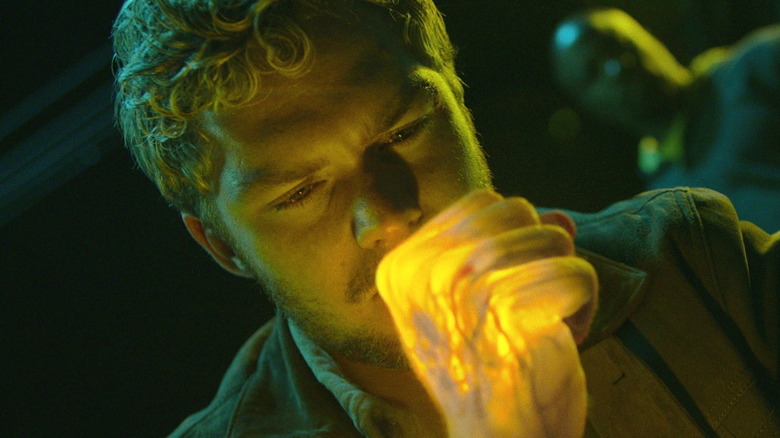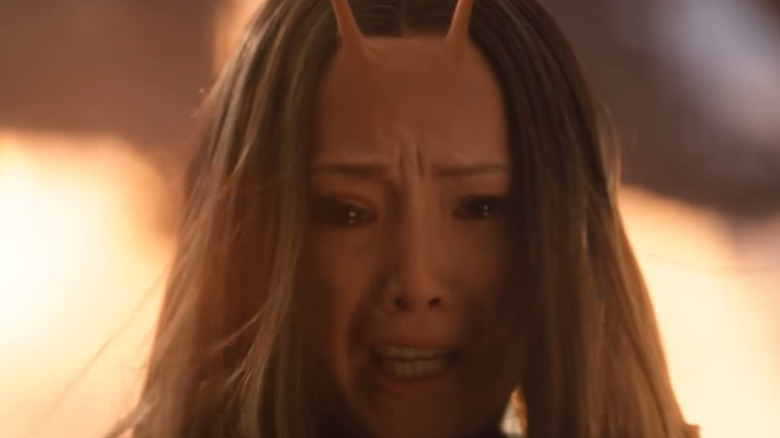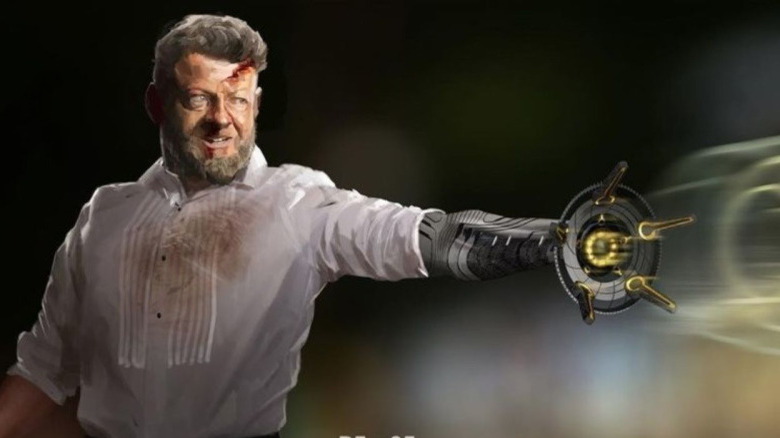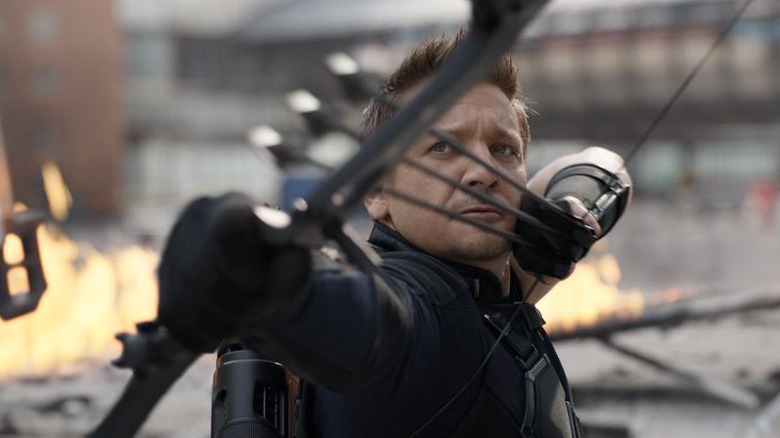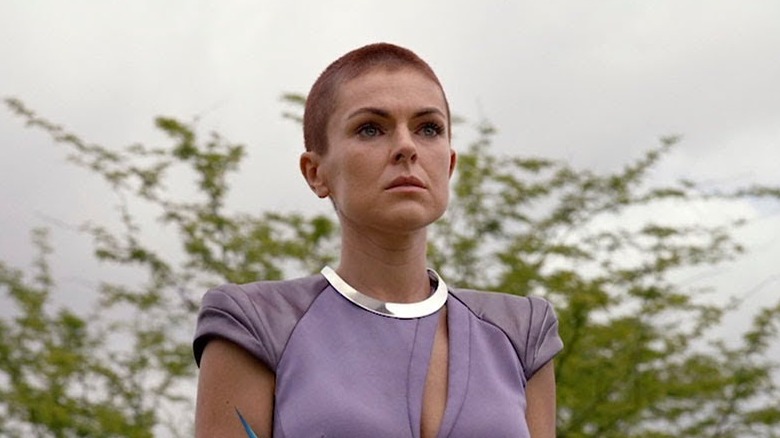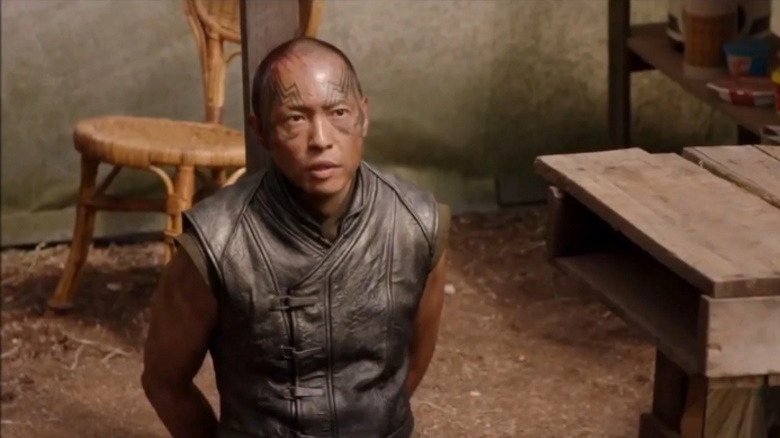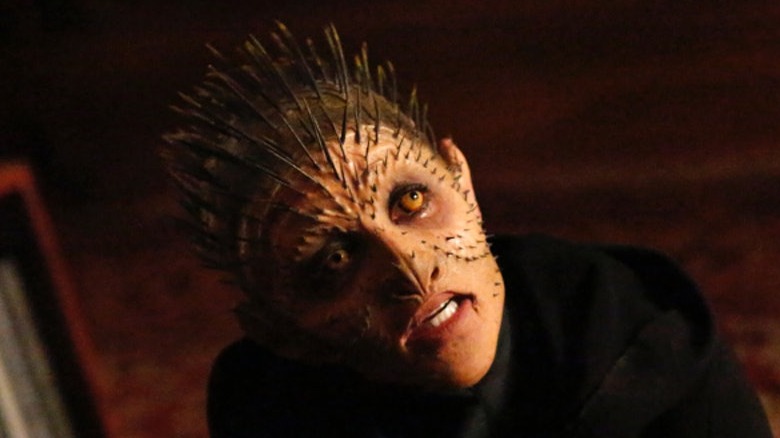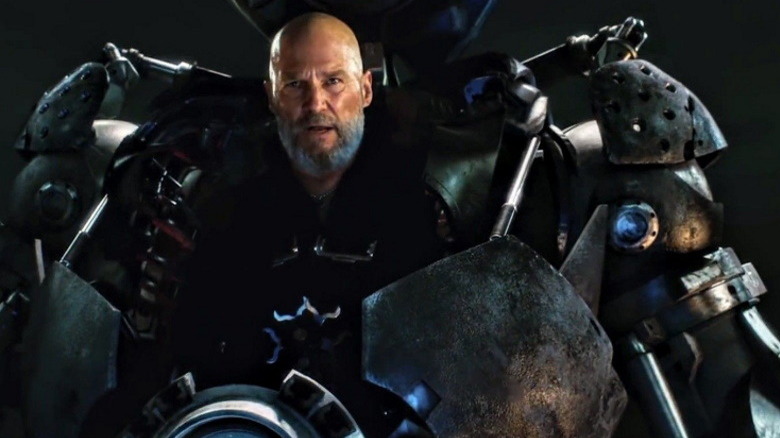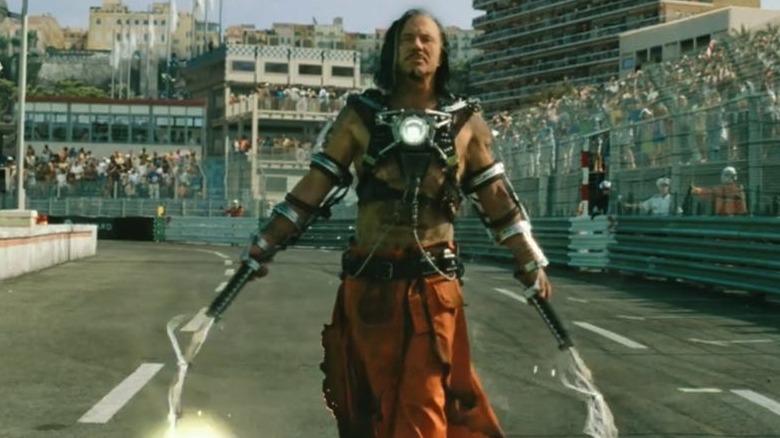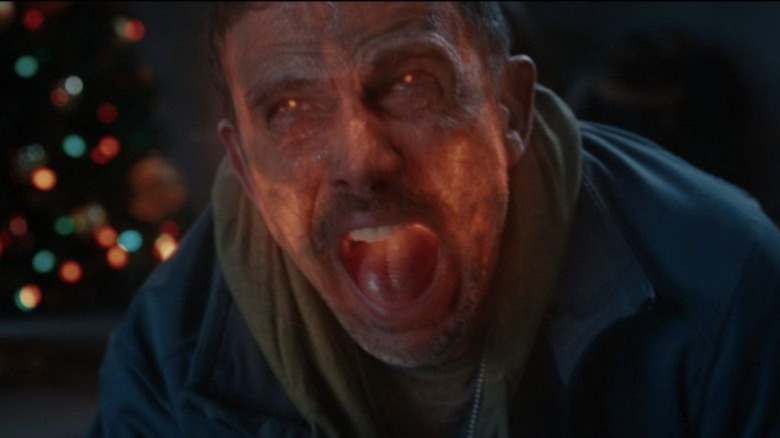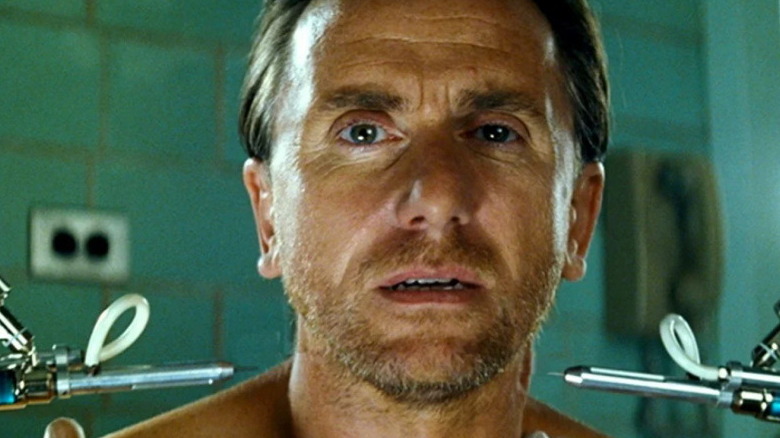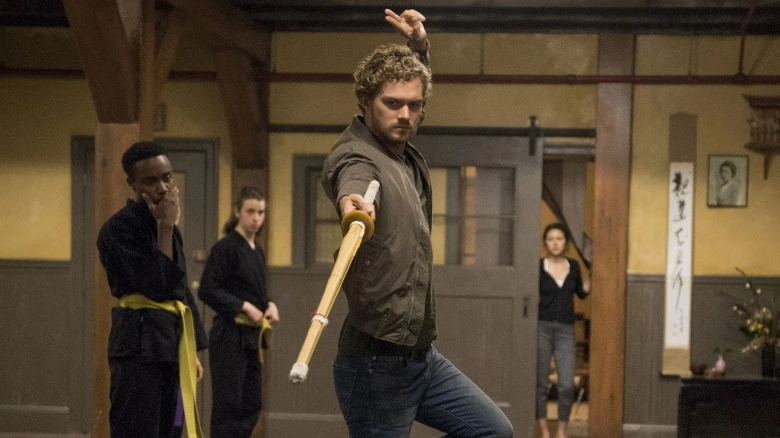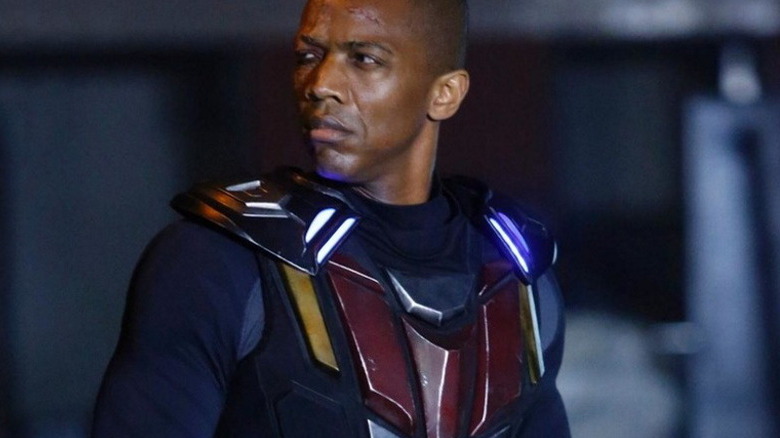The Most Useless Superpowers In The MCU
The Marvel Cinematic Universe is one place that just keeps getting bigger and bigger — and with all the superheroes, super villains, sorcerers, and aliens out there, the variety of superpowers you can receive are truly limitless.
Unfortunately, for every Iron Man or Captain America out there, you also have dozens of people who got the short end of the stick in the superpower lottery. Maybe they have special skills that are only "powers" in the loosest sense of the word. Maybe their powers have a major weakness that renders them useless in combat. Or maybe their powers are potentially awesome but never get a chance to really shine in the movies or television series.
Regardless, these are the abilities you don't want in your skill set if you ever need to face down Thanos or tackle a world-ending threat. No disrespect to the men, women, aliens, and cyborgs with these unique abilities, but these are the most useless superpowers in the MCU.
Mantis: The living Ambien pill
When writer Steve Englehart created Mantis for Marvel Comics back in 1973, he made her a very formidable heroine with multiple superpowers. Not only did Mantis possess mental abilities including telepathy, precognition, empathy, and astral projection, she could also control vegetation and set things on fire with her mind. This, coupled with her martial arts abilities, total control over her body, and ability to self-heal, made her a prime candidate to become the "Celestial Madonna" who would birth one of the galaxy's greatest beings.
Unfortunately, when Mantis was re-imagined in the James Gunn film "Guardians of the Galaxy Vol. 2" (2017), she appeared as a radically different version of herself that reportedly displeased Englehart. Played by Pom Klementieff, this Mantis is an insectoid being raised by the living planet Ego (Kurt Russell) to serve as his caregiver. Possessing only empathic abilities that let her feel the emotions of others, Mantis' greatest ability was her power to make those she touched fall asleep.
Which is actually a pretty awesome power — at least in theory. After all, if Mantis can knock out a Celestial god like Ego or render Thanos (who was wielding four Infinity Stones at the time) temporarily docile in "Avengers: Infinity War" (2018), surely a regular supervillain or alien warlord would prove no threat to her. Sadly, since she's constantly being called on to battle gods who quickly shake off her influence, her sleeping powers don't look anywhere near as useful as they might actually be.
Klaue: Talk to the hand (just don't listen to it)
The MCU has a tendency to greatly redefine characters from the original source material, often in an effort to transform them into a more grounded version of their comic book counterparts. That's certainly the case with Ulysses Klaue (Andy Serkis) who appears in "Avengers: Age of Ultron" (2015) and "Black Panther" (2018).
In the comics, Klaue is a physicist who becomes transformed into a creature made of solid sound thanks to a vibranium-powered sonic converter. Thanks to his new body, Klaue (or "Klaw" as he renames himself) possesses superhuman strength and is basically invulnerable. He also wears a prosthetic device on his right wrist, allowing him to create powerful sound blasts and even project solid sound constructs of elephants and other beasts at his enemies.
In the MCU, however, Klaue just has a prosthetic left arm made from Wakandan mining equipment after Ultron severs his real limb. While his new arm can fire powerful sound blasts, he was no match for Black Panther (Chadwick Boseman) or his Dora Milaje women warriors who easily captured him and removed his prosthetic arm. Later, the assassin Killmonger (Michael B. Jordan) managed to get the drop on him and simply shot Klaue, first in the stomach and then in the head, killing him.
Hawkeye: Does he even have powers?
By now, everyone has jumped on the "Hawkeye is useless without his arrows" bandwagon — including the actor who plays him. Back in 2015, Jeremy Renner appeared as "Hawkeye" on "The Tonight Show with Jimmy Fallon" and sang a parody version of Ed Sheeran's "Thinking Out Loud" song, mocking his bow and arrow skills.
While Hawkeye's "power" of super-accuracy does allow him to perform miraculous feats of coordination with or without his arrows (he once caught a machine containing the Vision while it was falling in mid-air by maneuvering his own jet beneath it and letting it slide through the back doors in "Avengers: Age of Ultron" (2015)), when you're on a team with gods and monsters, even the world's greatest archer isn't going to be called on to use his powers very often.
Interestingly, in his appearance on Fallon, Hawkeye claims he hasn't lost his virginity — although he's shown with a wife and three kids in "Age of Ultron." This suggests he can use his power of super accuracy in some ... unusual ways.
Medusa: She's got the best hair you've ever seen. Oh wait...
Within Marvel Comics, Medusa is queen of the Inhumans, a subset of humanity gifted with amazing superpowers following exposure to the "Terrigen Mist" that randomly mutates your genetic code in unusual ways. In Medusa's case, the mist gave her the power of prehensile hair — enabling her to move every strand of her long red hair like an octopus tentacle. Her hair is also tougher than iron, can strike with the speed of sound, and is strong enough to lift several tons.
When the Inhumans received their own one-season MCU television series in 2017, however, Medusa (Serinda Swan) received a major power downgrade. While her hair is initially strong enough to lift small objects, it turns out it's not anywhere near as tough as her comic book counterpart's. The first episode sees the main villain Maximus (Iwan Rheon) shave Medusa bald with what appears to be a regular electric razor. Medusa doesn't even appear to struggle or fight back that much during the scene, indicating that her superpowers aren't really that useful to begin with.
Karnak: The world's dumbest genius
"The Inhumans" is basically a television show about an arrogant, overprivileged family being taken down several pegs — and they don't come any more arrogant than Karnak (Ken Leung), an Inhuman with the ability to spot weaknesses in any object or person (except, apparently, himself). Karnak's ability to run complex calculations in his head allows him to play out multiple mental scenarios and then start a domino effect so he arrives at the one most favorable to him.
Sounds cool, but Karnak is so entitled that he insists on showing off how superior he is by letting other people know how a situation will play out. This extends even to romantic interludes, as he once shut down a female admirer by letting her know how every stage of their relationship (including their inevitable break-up) would unfold, essentially ending their relationship before they had a chance to talk.
In many ways, Karnak is the living embodiment of the supervillain who needs to explain every step of his master plan. However, he got a major comeuppance on the show when he suffered a head injury (despite supposedly being more durable than a regular human), which threw off his calculations and made him a ridiculously incompetent fighter. His powers did eventually come back, but since he lost them, did he ever really know how to use them properly in the first place?
Raina: She sees the future ... and doesn't like what she sees
Inhumans who undergo Terrigenesis tend to roll the dice when they get their superpowers — and sometimes those dice end up being snake eyes. Some fans feel this was the case with the manipulative scientist Raina (Ruth Negga), an Inhuman introduced in "Agents of S.H.I.E.L.D." While she hoped Terrigenesis would turn her into a divine entity, Raina mutated into an animal-like creature covered with quills. Where other people enjoy their superpowers, Raina found her new form uncomfortable as her insides felt malformed, and she tried to commit suicide following her transformation.
Still, Raina's mutated body had a few benefits. She gained enhanced strength and durability (although she wasn't bulletproof and couldn't overpower super strong enemies like Calvin Zabo (Kyle MacLachlan). Her thorny skin could also hurt opponents, although they did make getting close to people difficult.
However, Raina's real power was precognition, which allowed her to have visions of the future. This proved useful in some instances, but ultimately Raina foresaw her own death at the hands of Jiaying (Dichen Lachman), a human-hating Inhuman leader. Knowing her death would cause Jiaying's daughter Skye/Daisy Johnson (Chloe Bennet) to join S.H.I.E.L.D, Raina accepted her fate — although, having a power that basically shows you were meant to die for someone else's rise probably isn't what she wanted.
Iron Monger: Is his suit really superior in every way?
"Iron Man" (2008) is responsible for a lot of great things. It jump started the Marvel Cinematic Universe, showed the world that B-list superheroes could be box office gold, and reinvigorated Robert Downey Jr.'s career. Unfortunately, it also started the MCU's most embarrassing tradition — the lame villain.
To be fair, Obadiah Stane (Jeff Bridges) made a decent antagonist for most of the film. As one of Tony Stark's oldest confidants, Stane was perfectly positioned to secretly order Stark's execution so he could take over his company. He later murdered his hired assassins and stole Stark's original Iron Man design, even ripping Tony's Mark II arc reactor out of his chest when his own people couldn't duplicate the miniature battery.
Unfortunately, once Obadiah donned the bulky "Iron Monger" battle suit, his villain cred went right out the window. While the suit was definitely intimidating in design, it was also clunky and slow-moving. In essence, he was trying to fight Tony's iPhone with ... a Zune.
The only reason Obadiah was able to get a few good shots in at Iron Man was because Tony's replacement arc reactor wasn't operating at full power. Even then, Tony showed his suit could fly faster and handle high altitude temperatures better than Iron Monger, making viewers wonder why Tony didn't just hit Obadiah with a "tank missile" and get it over with — as depicted in a parody "How It Should Have Ended" YouTube video.
Whiplash: His powers look like they hurt him more than his enemies
"Iron Man 2" (2010) attempted to create a formidable antagonist for Tony Stark by bringing one of Iron Man's more obscure villains, Whiplash/Anton Vanko, to the big screen. Played by Mickey Rourke, this new bad guy actually managed to recreate Stark's revolutionary miniature arc reactor simply by using his father's old plans and some random tech.
Once Vanko did get his arc reactor up and running, but what he chose to do with his superpower left many audience members scratching their heads. First, he created twin electrified whips capable of slicing straight through cars and machinery — but not, oddly enough, his armored foe's metal suit. Then, he tracked an (unarmored) Tony Stark to a racetrack, but was unable to slice up his enemy, despite causing all sorts of peripheral mayhem. Finally, he got into a fight with the armored Iron Man without wearing a shirt, making some people wonder if he might just electrocute himself with his whips.
Vanko made one final appearance at the end of the movie, clad in a new armored suit that appeared more formidable. However, he was almost immediately defeated when Iron Man and War Machine (Don Cheadle) employed a dual repulsor ray tactic that Tony Stark invented while drunk. In a last-ditch effort, Vanko blew himself up hoping to take Stark with him, but he couldn't even do that right — Iron Man just flew away, presumably to search for a more worthy adversary.
Extremis makes you a time bomb
"Iron Man 3" concluded a trilogy filled with awesome heroes and largely useless supervillains — although it didn't always seem like the third installment would be so toothless. In fact, the movie's villain The Mandarin (Ben Kingsley) looked for some time like he might be Tony Stark's best antagonist to date — and anyone who has seen "Sexy Beast" knows Kingsley has the goods to be a terrifying baddie — but his ability to create untraceable explosions seemingly anywhere turned out to be all smoke and mirrors.
"The Mandarin" was actually disgraced British actor Trevor Slattery, whose greatest superpower seemed to be ordering room service from his hotel; the movie's real villain, Aldrich Killian (Guy Pearce), was using Slattery as the face of a fake terrorist group. Which was a great twist from writer/director Shane Black, but left so many paper tigers that nobody had any real bite.
Killian was experimenting on soldiers with his Extremis technology, granting them superpowers that gave them superhuman strength, the ability to regenerate, and the power to light themselves on fire. Those superpowers are cool, right? Well ... not exactly.
Most of the soldiers spontaneously combusted in unpredictable ways (forcing "The Mandarin" to claim the explosions were premeditated terrorist acts). Killian himself eventually landed in danger of going "too hot" from his experiments , causing him to melt through multiple Iron Man suits before being taken out by a malfunctioning prototype suit — and Stark's girlfriend Pepper Potts (Gwyneth Paltrow), who hit him with a metal pipe and blew him up with a repulsor ray.
Emil Blonsky: The super soldier serum enhanced his inner drug addict
"The Incredible Hulk" (2008) occupies an unusual place in the MCU franchise. Released the same year as "Iron Man," the movie has yet to receive any sequels (although Hulk's story continues in the "Avengers" and "Thor" franchises). However, the film did manage to whet its audience's appetite for more MCU superheroes — especially when the main villain Emil Blonsky (Tim Roth) was injected with a version of Captain America's super soldier serum.
At first it looked like Blonsky had hit the jackpot. After all, isn't Captain America the world's greatest human specimen? Well, yes he is — but as people who watched "Captain America: The First Avenger" (2011) know, the serum does more than just make you stronger and faster. It also amplifies whatever qualities you have inside you ... and in Blonsky's case, it amplified his addictive and competitive natures. Constantly chasing his next high and foolishly disregarding orders, Blonsky arrogantly taunted the Hulk, receiving a brutal kick that crushed most of the bones in his body.
The serum did heal Blonsky — but he just injected himself with more of the drug and later subjected himself to a dangerous gamma treatment that mutated him into the Abomination. While the power boost did make him more formidable, he was soon beaten by the Hulk and hasn't been heard from since. Rumor has it that Roth's Blonsky will be re-surfacing in the upcoming "She-Hulk" Disney+ show — here's hoping they give him some better powers this time around.
Iron Fist: He punches really hard ... sometimes
The "Iron Fist" Netflix series received a lot of disdain from viewers and critics, and sadly, much of the ill-will was deserved.
Although Danny Rand (Finn Jones) is supposedly one of the world's greatest martial artists, Jones' own fighting skills were limited and audiences noticed the scenes used multiple cuts (including 56 in a 35 second scene) to cover his inadequacies. The series also acknowledged this, as in one fight scene where a drunk Asian martial artist compared Rand's fighting to "a child throwing a tantrum."
By the time Netflix's Iron Fist made it into the ensemble show "Defenders," he had become the butt of jokes for other superheroes — a Marvel Aquaman, if you will — including Daredevil's mentor Stick (Scott Glenn), who referred to him as "a thundering dumbass." Daredevil himself gave Iron Fist a massive beating at one point, making the martial arts superhero's fighting abilities appear largely lackluster.
Okay, but what about the famous "Iron Fist" power that lets Rand punch really hard? Well, unfortunately, in the Netflix series Danny could only manifest his superhuman punch when he channeled his chi energy into his hand and wrist — and it took considerable time and effort to build up such energy. It was reminiscent of one of those fighting games where you need to hold down a button to power up your super-punch — but villains keep kicking your butt while you're trying to do that.
Drugs, emotional issues, and his mental state all kept Danny from using his superpower, sometimes for hours or even a day, making it extremely unreliable. In a world full of superhuman characters who can all punch hard, it's unfortunate that a man who calls himself "Iron Fist" often cannot punch very hard at all.
Deathlok: He has a very powerful ... appetite
"Agents of S.H.I.E.L.D" built up a loyal fanbase, who loved the adventures of the brave men and women who put their lives on the line for the safety of the world. However, not all of their allies stood on equal footing — not even the superhuman known as Michael Peterson (J. August Richards). Because while Peterson gained superhuman strength, speed, durability, and agility thanks to the Centipede device attached to his body, his powers were limited.
For one thing, while his physical abilities were formidable, they were still inferior to Captain America's, despite the fact that Peterson gained those abilities from a combination of Extremis, gamma radiation, and super soldier serum (all elements that have had very negative effects on other superhumans). The drugs also left him with a monstrous appetite, one that caused him to eat about four times more than your average person just to keep his energy up — and ten times as much after using his strength. Making matters worse, he has to crash afterwards, because all that food digestion is very hard on his body. So essentially, every day for this guy is Thanksgiving.
Eventually, Peterson was rebuilt into the cybernetic killing machine known as Deathlok. While his bionic implants do compensate for some physical shortcomings, it allowed him to be hacked and mind-controlled, creating a liability to himself and his teammates. What's worse, by retaining even a fraction of his massive appetite, he could cripple whatever super team he's on with just his grocery bill.
